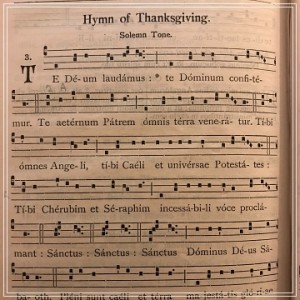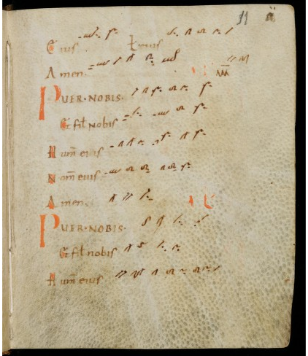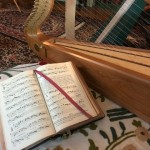Every Sunday for our service prelude I play the liturgically appropriate Gregorian chant for the day from the Roman Catholic Liber Usualis (this is a fairly conservative traditional New England Episcopal church). I also play another one for the Communion, sometimes with husband George accompanying on the pipe organ.
Usually I start out by playing just the melody as noted through once, then play it a second time adding a counterpoint. I should note that my favorite harp to do this on is my wire cross-strung harp Stoney End Esabelle… small, lightweight, very portable, extremely flexible and tonally a beautifully instrument. But given that Gregorian chant uses just one accidental: B flat, you can play these on your lever harp.

Modern typeset Gregorian chant. It was traditionally handwritten with ink quill pens in bound parchment illuminated manuscripts.
The square note neume notation is medieval; its origins date back to approximately 1200 A.D. Prior to that time, in various parts of Europe, chant notation tended to be staffless. Aquitanian notation, such as that seen in the sequences in the St. Gall codex (930-940 A.D), shows a series of stacked dots, dashes and curved lines.

Source: St. Gallen, Stiftsbibliothek, Cod. Sang. 484, p. 11 + p. 12 – Tropary (https://www.e-codices.ch/en/list/one/csg/0484)
This very early notation eventually evolved into the Gregorian neumes on a four line staff during the Middle Ages which are still used and typeset into today’s chant books.
My 1934 copy of the Liber Usualis has a couple of very helpful introductory sections at the front of the book; the first one is entitled, “Preface to the Vatican Edition of the Roman Chant” and this has a very useful chart identifying all of the neumes shapes and their names, among other basic concepts necessary to get started reading Gregorian chant.
The second, and considerably longer, tutorial piece is headed, “Rules for Interpretation”. This section is very detailed, with numerous illustrations from clefs to more complex phrases of music, and the corresponding interpretations for understanding them.
I’ll go through these sections here on my blog and try to demonstrate how to apply this vocal music to harp. Gregorian chant was and is intended to be sung… but that hasn’t stopped composers over the centuries from writing organ preludes and Communion pieces! There are thousands of Gregorian chants, by the way… the Liber Usualis is but one repository of them. The Catholic Church has authorized the publication of graduals containing many chants throughout the liturgical year. Also there are manuscripts available online - e-codices, the Virtual Manuscript Library of Switzerland – is one of many resources hosting sacred music manuscripts from the Middle Ages which are freely available for research and download.
Every now and then someone will ask me “how to play harp”. This is a really large part of what I do and it’s probably my strongest area as a harpist, because it was my undergraduate concentration when I was studying music. The other area is playing harp accompaniment on the hymns with the pipe organ and congregational singing. However, I’ve found over the years from Catholic friends and other harpists there’s a lot interest in Gregorian chant. I’ve also found that it’s very welcome in the Episcopal Church! (We have our shared traditions, apostolic succession, and other ancestral faith matters that I won’t go into here).
Please check back often as I continue to add new posts.
Soli Deo Gloria

